THE VERY FIRST STEPS
Girls with the diagnoses Rett syndrome can have many different kinds of symptoms and various degrees of neurological and muscular disturbances.
Some girls walk others don't, some have severe epilepsy, others barely, some are mainly happy, others have severe screaming spells, with major breathing
problems or none, major chewing problems, problems with digesting food, severe constipation or just minor difficulties. But one thing they all have in
common is the wish and need to communicate with their surroundings. It is not only a wish of these Rett girls, THE ABILITY IS THERE!
Besides that, Rett girls like the people around them very much, they usually communicate with their eyes and their handsome smiles.
Many girls remain at that level because the people around them do not teach them otherwise, they do not teach them other forms of communication.
Healthy children who are raised naturally, will step by step, and without much external help, develop their ability to communicate with
their parents, peers and others. They learn to talk, to point, to show what they want or do not want. To listen to what is said to them and they
learn the basic principles of human behaviour. For healthy children it is a completely spontaneous and almost autonomic process.
With Rett girls however this is not the case at all. They need others to teach them how communication works.
These others have to think it out for them and to plan in detail how to teach them this ability step by step.
There are three principles that will boost the effectiveness enormously:
- firstly an unconditional DETERMINATION combined with much patience,
- secondly TRUE LOVE
- and thirdly an unreserved trust and DEEP HOPE
that together we will succeed.
Do not get disappointed as time passes, do not be limited by the days weeks or even months that pass by without reaching
your first goals. My impression is that, when it seems there is no progress at all, exactly at that moment something can change in your Rett girl! So: do not give up easily.
She learns and she understands. Maybe just some more persistence or some more creative ideas will induce positive changes.
It is very important to know that persistence, besides hope and love is something that we need most.
And now as we followed the above-mentioned principles we still had to make sure we got:
the right EQUIPMENT,
a good PLAN and much KNOWLEDGE about the first steps of teaching her to communicate.
It is best to start out with a very clear and simple set of programs and materials. With that we proceed, step by step,
towards our closest goal and that is a dialogue between ourselves and the Rett girl, aided by some technical materials and equipment.
|
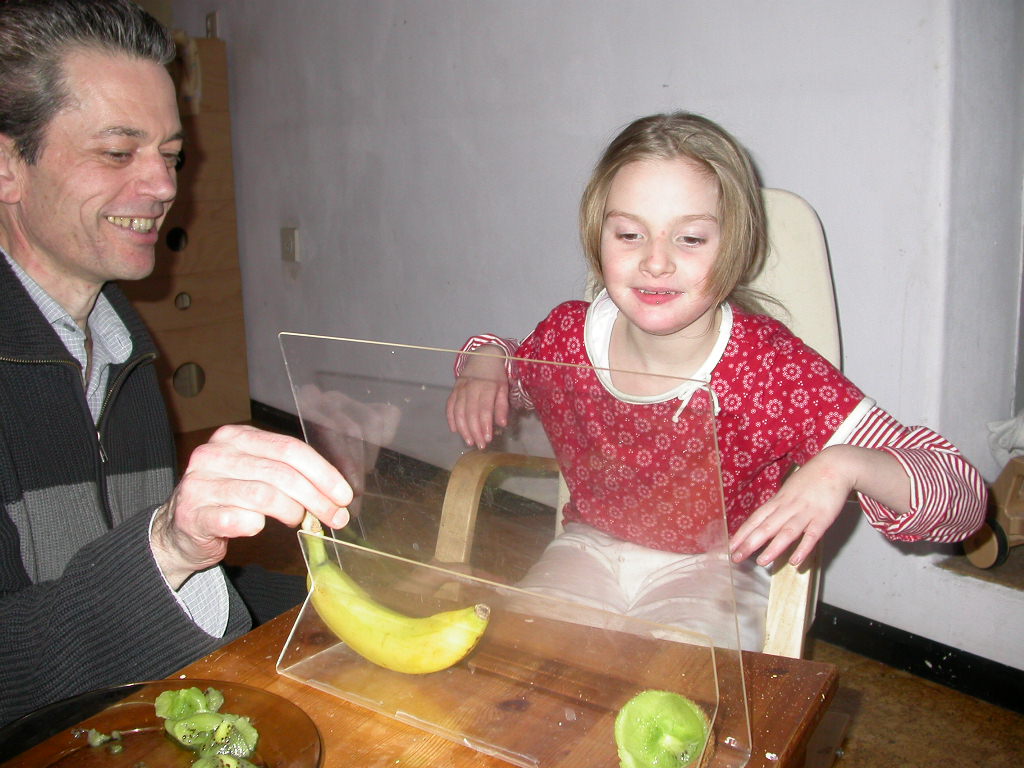
|
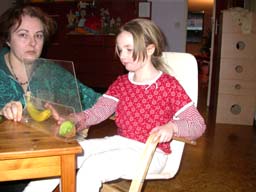
|
PLANNING and GOALS
The first thing we did was to have her hearing tested because it is possible that the child does not hear well in one or both ears. Hearing well is a
important feature for her to understand sounds and the spoken words around her. If there seems to be any problem with hearing it is best to consult a
specialist. Our daughter had and has excellent hearing but did not react to sudden and strong sounds, the same thing occurs in many autistic children.
To get her familiar with all these sounds we confronted her for some time with series of high pitched and low pitched, hard and soft noises and tones.
These were her first exercises in communication.
1 ___ We taped all kind of ordinary domestic sounds on a plain cassette recorder.
We taped the sound of the phone ringing, the washing machine working, our dog barking, the
front doorbell ringing, the coffee machine operating, children playing on the street, the sound of the shower in the bathroom,
sounds of dishwashing, the printer of the computer and so on. Before each sound on tape, one of us gave her a short and clear description,
for example: 'the dog barks' or 'the shower runs' or 'the doorbell rings'. Then, after a short break the relevant (recorded) sound could be heard.
We let her hear this tape once or twice every day, week after week for several months. Later on we showed her the location of
these sounds and sometime even let her feel them. On every occasion we described the sounds in a very clear and uniform manner.
For example "look Dejana, the washing machine is working".
Today our daughter reacts very well to all the sounds surrounding her in normal life,
she quickly turns when she hears the door opening, when the bell rings and perfectly understands the world around her, because
this world is no longer chaotic for her. I would advise that you consult your physician or specialist when starting with these
kinds of exercises, maybe he or she can give some valuable input or propose a different way to reach your goal.
2 ___ As we started our own communication program the first thing we had to learn was the golden rule of every successful communication exercise: To speak with your daughter in short sentences and to pronounce every word very clearly and to repeat the important parts several times. Also it is essential to face her with your eyes on the same level as her eyes and to articulate as best as you can without nervousness, anger, impatience or haste. To be there only for her with a bright face. This is especially important because Rett girls are extremely sensitive to the emotions they sense in people around them. Their ability in this field is extremely well developed; they sense any mood change when we are with them. We expect a big effort in terms of concentration and learning , and this can only be achieved if we ourselves feel good and enthusiastic.
3 ___ We know that Rett girls clearly wish to communicate with adults around them.
However this does not mean that, from the beginning, they consciously understand the existence of communication
between people and that they understand the complex relation between cause and consequence. In the early phase of
development a child normally does not always know what troubles him/her (hunger, pain in the stomach, tiredness,
unpleasant sounds, thirst, wrong position of body parts), and even less does she know that she has to express this to someone else.
This is of course the ultimate goal of developed communication.
Like a small baby our Rett girls react to all kinds of disturbances with screaming and crying spells which are very
difficult to resolve. For them crying is the only way of communication, because when they cry there is always a reaction
from someone who solves their problem. Therefore as long as we react immediately to her crying when she is dissatisfied,
she will persist in that kind of behaviour and she will not feel the need to change any of it. Solving a child's actual
problems at the moment she starts to cry means that we in fact teach and stimulate her to go on with that kind of behaviour.
Unfortunately, with this reaction, we prevent her to establish other means of expressing her needs. These other means would be
much easier, for both the child and parents, if she could learn them. Therefore this is the next step that has to be taken.
As we prepare communication materials we can, when the child cries, go to her and ask her calmly "why do you cry "?
We can offer her various possibilities to choose from.
In the beginning she will not understand what we want.
Therefore we patiently wait a few minutes, I started with 5 minutes but had to prolong it, and then we will help her to point.
Even if there is no reaction, we will give her what she wants at that moment anyway. She will then gradually understand that
crying is not a sufficient signal and that we do not understand her quickly enough when she cries. If she is hungry or thirsty,
she will very quickly understand that if she expresses that with the communication means we offer her at that moment, we will
respond adequately and much quicker. And contrary, if she cries we respond very slowly. But we have to be very persistent in
that approach!! These moments are especially important because when children want to eat or drink, they are very motivated to communicate.
We have to use this window of opportunity; and ignore how nervous we get when she cries. Of course if a child cries because of a fall
or anything like that, we will react immediately and help or comfort her. In other situations that are not really urgent, we just offer her our interesting communication material and wait
a few minutes or longer for her to react.
4 ___ Why is it so important to react with questions to her crying and to use visual support materials? Because it stimulates the child to learn to understand, on her own, what the nature of her needs are. It stimulates her thoughts, her awareness of body and surrounding, it stimulates her to make contact with her surroundings and teaches her about cause and result. The latter is of utmost importance for the cognitive development of the brain. When we show her a banana and a piece of cheese she has to learn that if she points first at the banana, she will get a banana, or if she first points at cheese, she will get cheese, only then the communication window for her will be opened. It means that if she wants a banana it is not sufficient any more for her to open her mouth or to grasp it with her hand. Now she has first to point out the object that resembles a banana and that is lying there aside, and then she will get it.
|
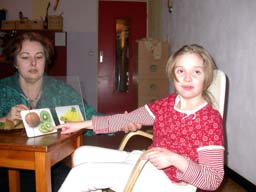
|
5 ___ So the first step in teaching a child about communication is that she understands what is troubling her, then she has to make the effort to recognise it on a picture or object and finally she has to understand that somebody will always help if she points to what she needs at that moment. This last phase is the most difficult but in this phase the complex ability to communicate with other people begins. Therefore in this phase it is very important to use things that motivate the child the most: like food or drinks, and it is important that after she points at the picture or object she always gets it! Meaning every time a girl points at what she wants, she gets it immediately and without any exception. Without clear signals of her understanding the relation between cause and result - real communication - will never take place. Only later when she has mastered the previous skills, we can expand this to others areas of interest, like the choice between listening to music, watching video, massage, swimming or some other activity she likes very much.
6 ___ Our next goal was to let her make free choices between two things we offer her, again a very important step in planning, thinking and communication. Therefore we used two kinds of food in the beginning. That meant that she had to learn and combine the shape, the colour and the taste of the things that she ate. In order to practice this effectively it was necessary to go stepwise, from simple exercises to more complex ones. At first we used two kinds of food of which we were certain that she either liked them or disliked them. We combined chocolate with carrots, raisins with tomatoes, strawberries with cauliflower etc. It was important that the foods were different in colour in order to help her to distinguish them quickly. After a while the differences were smaller and smaller and finally, we let her choose between foods that were very similar, like two kinds of fruit, or two kinds of vegetables and all other kind of food related items in pairs. Today she recognises everything she eats, she responds quickly and correctly the moment she sees what we offer her, she chooses for the things she likes, without mistakes. She is very satisfied and often smiles to and with us if we communicate in this manner. We can now even make jokes in the process and sometimes give her exactly the opposite of what she wants, at first you can see her surprise and then she almost can't stop laughing. This is of course not something to practice in the first year, just leave it until the time when she has mastered all the previous skills.
7 ___ It is good to start first with the real objects. It means: real fruit or vegetable that is put behind the Plexiglas display. If she masters that the next step is to make photos of the fruit/vegetables as clear as possible on the white/light gray/light yellow beck ground and to put them in her display. Slowely we can edd tree, fore, six or more photos. And if she masters that all we can start with using a symbols instead of photographs. Symbols are the first step toward characters but I would never start with them before the basic of communication is established.
8 ___ After we had overcome all this and after a year of teaching her to communicate in her playing room, we started to use the same method in other rooms in
the whole house, and outside and then in her school and when we pay visits to others. The result has been astonishing and we are now ready for the next
phase in communication, but on that subject I will talk some other time.
MEANS OF STARTING COMMUNICATION
On this moment all communication means can be devided into three groups:
NO-TECH; these are means without any electronic, without batteries, without recorded voices or any other mechanisms. This learning equipment is best used in the beginning, because they are interesting, clear and easy to understand for children. They can be easily replaced and with a little creativity and skill they can be self made out of ordinary materials. We used them intensively for one year, but now we changed them for:
LOW-TECH; these are means that produce speach (single words or sentences), they operate on batteries and they consist of an audio tape and can be programmed to function on more levels. They should be used with children that already mastered the first steps of communication. They are not easy to make yourselves, normally they are ordered through catelogs of Alternative and Augmentative Communication means.
HIGH-TECH; these are means that in some or other way make use of computers, CD disks with complex programs, special keyboards, mechanic devices operated by computers and ofcourse the electronic wheelchair. High tech means are in my opinion not best suited for our Rett girls, but still it is not bad to mention them here, although I will not alaborate here more on them.
NO-TECH
It consists of various boards, displays and all kinds of communication cards.The cards are normally placed upright in the beginning so that the child can
see them easily and is better motivated to look and touch them. Our first vertical board was made out of plexiglas. The display was constructed in such a
way that it could tolarate a child hitting it with her hand without the display falling over. The stability of the materials used is very important with
Rett girls because of there weak hand coordination. Equallly important is to use a BIG surface that can tolerate mistakes in the movements and that are
also easy to wash and kept clean.
FIRST picture is an example of such a plexiglas display.
SECOND display is very suitable for communication with your daughter, because those who sit opposite to her (the best position in the beginning!!)
can look through the display at her eyes [eye to eye contact]. In this way you can see at what card see looks and you can assist her with the
fine motor movements of her hands. All displays that make this special eyecontact possible are known under one name; we call them "eye communicators".
Some frames are made of plastic or metal tubes.
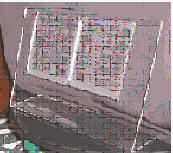 first ____ second
first ____ second
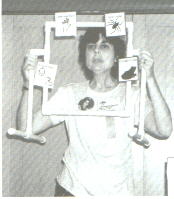
In the case you are not able to buy such a display, you can use temporarely a display made of ordinary plastic,
thick cardboard or wood in a standing position. But I would not advice this variant in the beginning.
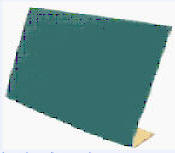
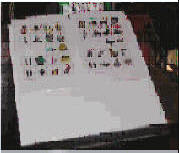
Here is an example of a display that you can use later. It is available in various dimensions
for home use or in a smaller format for travelling.
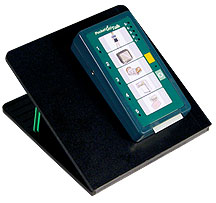
After you have selected a suitable display, we proceed with the selection of communication cards. In the beginning it is best to use threedimensional
objects of those things that our Rett girls are interested in most, and that is FOOD. We selected in a very early stage two kinds of food,
one she likes very much and one she dislikes very much. We also took care that we selecteds foods that were very different in both colour
and form and we placed them as far apart in the display as possible. In that way we made it much more easy for her to understand what it
was we wanted from her. Besides it made it also easier for us to determine if she understood well what she pointed at. We used fresh fruit.
If it was to big we cut it in small but clear to see pieces. Ofcourse it is also possible to use plastic fruit or vegetables that can be bought
in a childrens toy shop or ordered through internet for a very reasonable price. Here are some examples where threedimensional playobjects are
used in combination with or without symbols.
It is also possible to stick a real object to a white card board (cup, video tape or spoon as a symbol for eating)
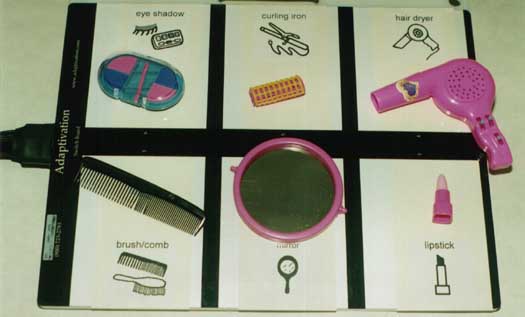 ____ or ____
____ or ____
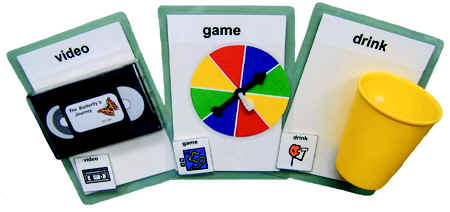
You can also use magnetised cards with clear outlines.
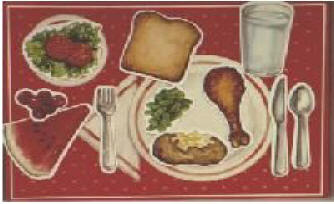
There are uncountable ideas to work with, you only need some creativity and a litlle bit of craftmenship to make them. In this way there is only a
limited effect on your family budget. If your daughter is coming along fine in communicating with real threedimensional objects it is time for the
next step e.g. communicating with twodimensional pictures or photos. It is essential to use very clear and unambiguous pictures placed on a white background.
We used our plexiglass display to put the pictures in. Some of the picture cards we made ourselfes and some we bought via Internet.
You can also buy a CD with numerous pictures on it and share it with other parents in order to limit the costs somewhat.
Her are some examples of communication cards:
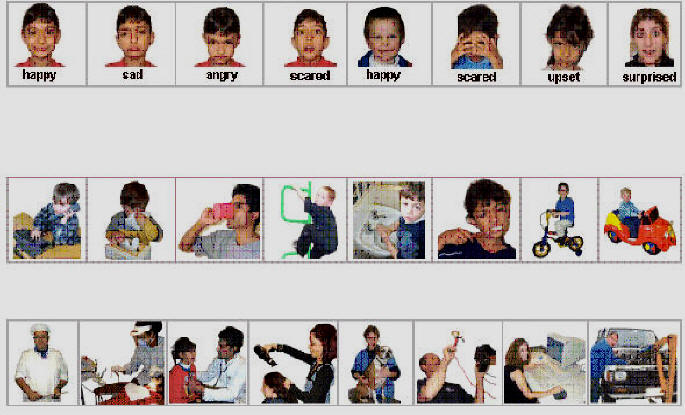
You can order them at: http://aba-materials.com
Later you can put the display flat on the table. Or you can design it like a photo album with on each page 1 or maximal 2 pictures. When you open it the child can see in front of her 1+1 or 2 + 2 pictures
 _____ or home made variant
_____ or home made variant
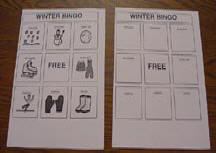
With these materials one can practice for a very long time, because you can always extend the number of choices on one page. You only have to make the pictures smaller. And even later you can start to use pictograms in stead. The child will finally learn to make a choice and to communicate that to us and in return to expect to get the chosen object. Arrived at this moment we already have come a long way. We have given the child new ways to express and develope herself. And we are able to have a much better and human bond with her. Moreover we have helped her in socialising. Everyone arround her will acknowledge and respect her more because she can communicate with them. The girl is from that moment on no baby any more but a child with some motoric difficulties. I have the impression that this significantly changes the attitude of people towards Rett girls. And that is something that we as parents deep in our heart are longing for.
LOW-TECH
In this category we also find communication board and cards but on a more sophisticated level.
The boards are electronic,
with batteries and they can produce speach when activated.
That makes communacation even more funny and exciting.
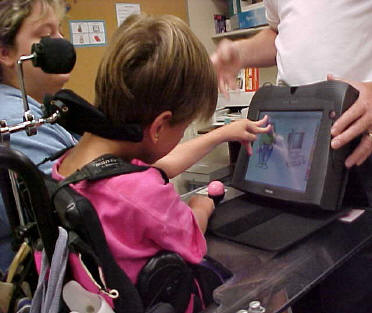
Below are examples of electronic boards with pictures on top and with a limited audio tape beneath. On it single words or small messages of 20 till 30 seconds can be recorded. In the beginning it is best to start with clear words like - I want a banana, I am hungry, I am thursty, I want to watch video - and so on. We were told by our speach therapist it is of great importance to use the noun "WANT" because it will teach the Rett girl she has a wish of her own. It is also the key to engage into activity, one of the weakest points in Rett girls. The words have to be pronounced with great clarity (BA-NA-NA), in between words there should be short silent intervals.
The simplest board device has only one cassette which is activated with a button.
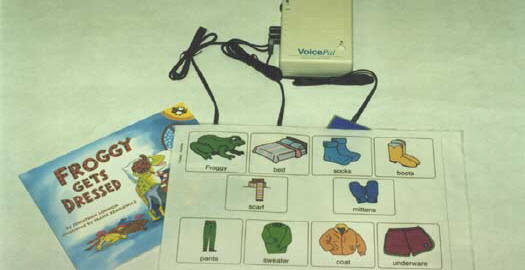
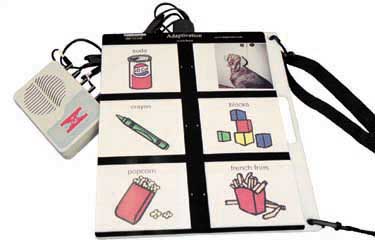
Here some examples of devices with more casettes the so called "One button One message" devices.
You can stick laminated pictures on the buttons and change the pictures when needed.
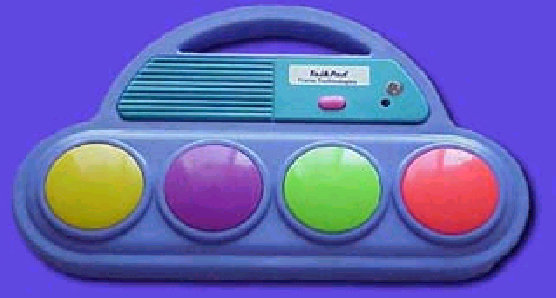 _______ and more expensive variant
_______ and more expensive variant
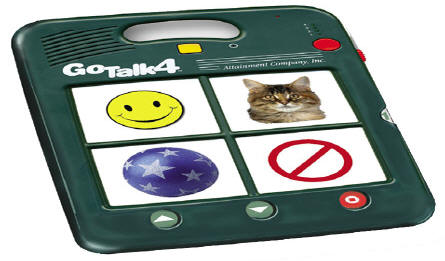
Not so expensive is the button switch called "BIGMACK" it operates on batteries and works like a answering device.
Whenever you want, you can change the message you want to be heared when the button is pressed. You can also use two or more of these devices.
They can be bought in six coloures. On the button you can stick a picture or drawing of your wish. The buttons can be fixed together
but its is better for Rett girls to use them stand alone, one for each hand.
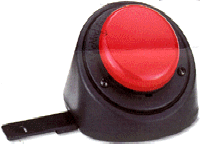
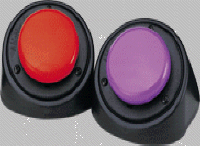 ___ for les precise hand function
___ for les precise hand function 
They come in various sizes, suited for thumb, pointing finger or complete hand depending on the motoric capability of your child.
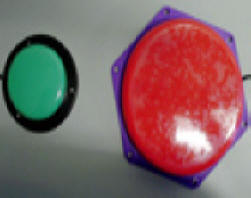
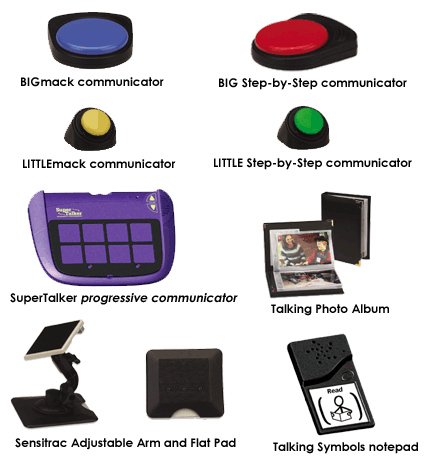
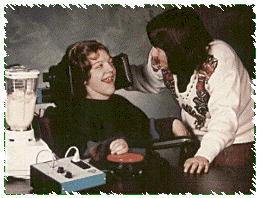
Finally an example how pictures and photos can be replaced by symbols, the next important step in developing communication.
Symbols are the bridge to CHARACTERS and that means the possibility to read. But lets not leap too far in the beginning!
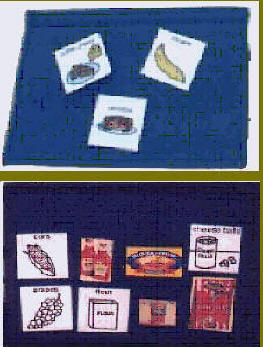



 first ____ second
first ____ second




 ____ or ____
____ or ____



 _____ or home made variant
_____ or home made variant




 _______ and more expensive variant
_______ and more expensive variant


 ___ for les precise hand function
___ for les precise hand function 



